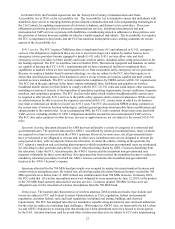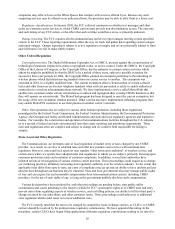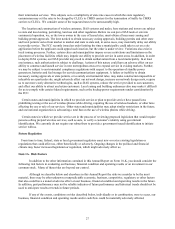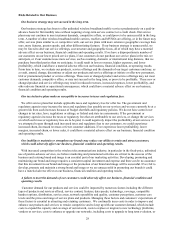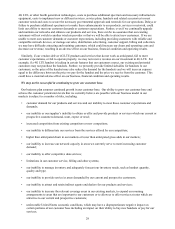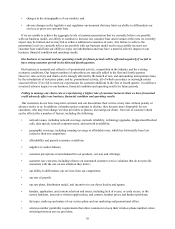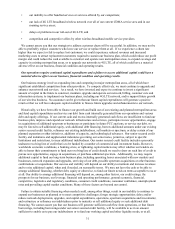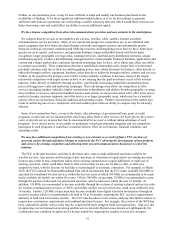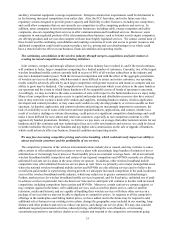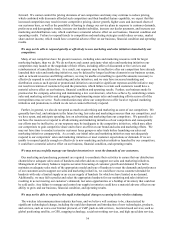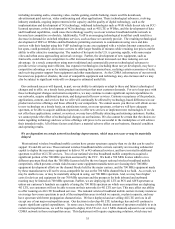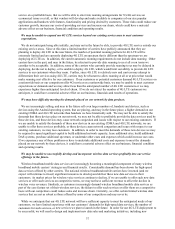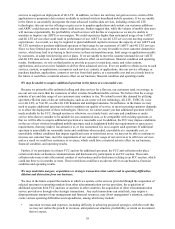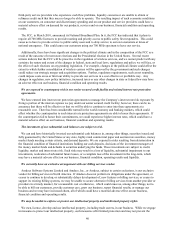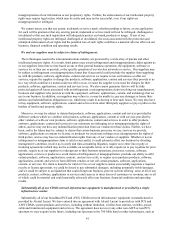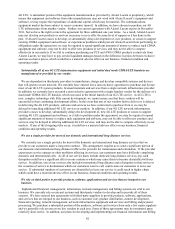Metro PCS 2010 Annual Report Download - page 43
Download and view the complete annual report
Please find page 43 of the 2010 Metro PCS annual report below. You can navigate through the pages in the report by either clicking on the pages listed below, or by using the keyword search tool below to find specific information within the annual report. 33
ancillary terrestrial equipment coverage requirements. Stringent construction requirements could be detrimental to
us by fostering increased competition at an earlier date. Also, the FCC has taken, and in the future may take,
regulatory actions designed to provide greater capacity and flexibility to other licensees, including our competitors,
and could allow companies that are not currently our competitors to offer competing products and services. In
addition, some companies in non-telecommunications businesses, including cable, energy companies and utility
companies, also are expanding their services to offer communications and broadband services. Moreover, some
companies in non-regulated portions of the telecommunications business, such as Internet search engine companies,
are offering products and services that compete with our more highly regulated services. We cannot control most of
these factors and the continuing consolidation and resulting economies of scale and access to greater resources and
additional competition could result in greater product, service, pricing and cost disadvantages to us which could
have a material adverse effect on our business, financial condition and operating results.
The continuing consolidation in the wireless industry through mergers, acquisitions and joint ventures is
creating increased competition and marketing initiatives.
Joint ventures, mergers and strategic alliances in the wireless industry have resulted in, and if the trend continues,
will continue to foster, larger competitors competing for a limited number of customers. Currently, two of the largest
wireless broadband mobile carriers currently hold in excess of 60% of all wireless subscribers in the industry and
may have dominant market power. With the increased competition and with the effect of the aggregate penetration
of wireless services in all markets, which has made it more difficult to attract and retain customers, our operating
results could be adversely affected by such larger competitors with greater resources and means to compete and our
ability to grow may be hindered. Our competitors have licensed spectrum which is not always in the same bands as
our spectrum and the extent to which future handsets will be compatible across all bands of spectrum is uncertain.
Accordingly, we may not achieve the same economies of scale with respect to the future handsets as we enjoy today.
Many of our competitors with greater access to capital and production and distribution resources also have entered
into or may enter into exclusive deals with vendors and suppliers, including handset vendors, wireless application
developers and content providers, or may cause such venders to only develop products, or services useable on their
spectrum. As handset, application, and content selection and pricing are increasingly important to customers, the
lack of availability to us of some of the latest and most popular handsets, applications, and content, whether as a
result of exclusive dealings or volume discounting, could put us at a significant competitive disadvantage and could
make it more difficult for us to attract and retain our customers, especially as our competitors continue to offer
aggressively handset promotions. Similarly, we believe we pay more, on average, than other national carriers for our
handsets and if this continues and new technologies force us to offer new handsets and services, we could be forced
to further subsidize the price of our handsets and pay higher sales commissions on the sale or upgrade of handsets,
which could adversely affect our business, financial condition and operating results.
We may face increasing competitive pricing and service bundling, which could adversely impact our ability to
attract and retain customers and the profitability of our services.
The competitive pressures of the wireless telecommunications industry have caused, and may continue to cause,
other carriers to offer unlimited service plans or service plans with increasingly large bundles of minutes of use or
unlimited use at increasingly lower prices or fixed monthly prices on a national coverage basis. All of our national
wireless broadband mobile competitors and certain of our regional competitors and MVNOs currently are offering
unlimited fixed-rate service plans in the areas where we operate. In addition, other wireless broadband mobile
competitors may offer unlimited fixed-rate service plans as well. Since we primarily serve major metropolitan areas
where the national wireless broadband mobile carriers and MVNOs are also offering services and we believe the
overall post-paid market is experiencing slowing growth, we anticipate increased competition in the paid-in-advance
sector of the wireless broadband mobile industry, which may subject us to greater commercial disadvantages.
Further, market prices for wireless broadband mobile services in general, and for fixed-price, unlimited use of paid-
in-advance services in particular, have declined over time and we anticipate will continue to decline with increased
competition, including competition from carriers and MVNOs. Moreover, certain carriers we compete against, or
may compete against in the future, offer additional services, such as wireline phone service, cable or satellite
television, media and Internet, and are capable of bundling their wireless services with these other services in a
package of services that we may not be able to duplicate at competitive prices. In response to all the competitive
offerings in the marketplace and falling market prices, we have added, and in the future may be required to add,
additional select features to our existing service plans, change the geographic areas included in our roaming, long-
distance and other products and services, reduce our prices, and change our service plans. We may also consider
additional targeted promotional activities, reduced pricing, subsidizing the cost of handsets, or increasing
commission payments to our indirect dealers as we evaluate and respond to the competitive environment going


